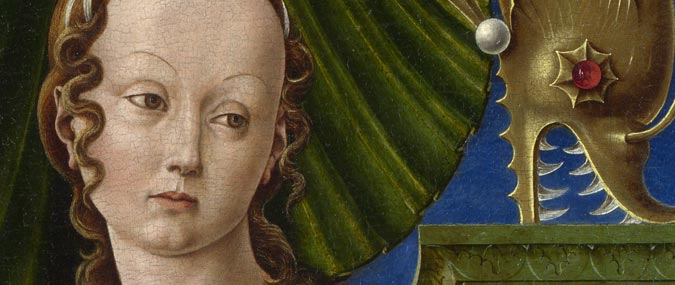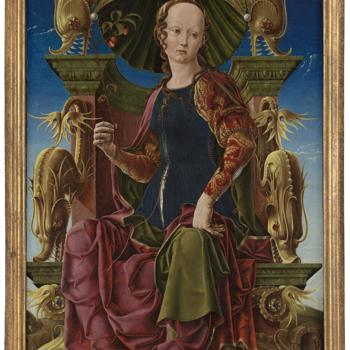A Muse (Calliope?)
Jill Dunkerton from the Conservation Department shares the history of A Muse (Calliope?) by Cosimo Tura.
X-rays and infrared reflectograms have revealed that this 15th-century painting was originally started by another artist. Discover how the young Tura took it over and made it very much his own.
Art in the Making: A Muse (Calliope?)
Transcript
Jill Dunkerton: I’m Jill Dunkerton. I’m one of the restorers working in the Conservation Department here at the National Gallery.
This has to be one of my favourite pictures in the collection. I find its history, its technique and its astonishing appearance absolutely fascinating.
Female Voice: This painting by Cosimo Tura is one of a set of nine panels commissioned in 1447. They were to decorate a study for the Duke of Ferrara.
Jill Dunkerton: In 1447 Tura was still a small boy. And in fact the job went to another painter, very little-known nowadays, called Angelo Da Siena. It seems that he started and managed to finish two of the muses – and start some of the others – before he died. Rather later on in 1457 (Tura would by then have just established himself as a painter) was given the job of finishing off the group of muses.
This one, on the surface, is entirely by Tura. But as a result of technical examination – of X-raying and infrared examination – we discovered that there is in fact another unfinished muse underneath. Originally we thought it might be by Tura but I’ve now become pretty sure that in fact it was by Angelo Da Siena and that Tura took up this unfinished panel and radically reworked it, but keeping some elements of the original design.
The thing that’s really exciting about this figure is the astonishing underdrawing revealed by infrared. Tura was one of the greatest draftsmen of all time. I think he could just draw anything out of his head and he drew with this very bold strong line. You can actually – if you look very closely at the dark-red drapery – see some of this underdrawing where it’s now become slightly visible as the paint layers above have become more transparent. And it’s boldly hatched with diagonal lines to work out the relief, the volume. He draws like a sculptor.
The other thing that’s very remarkable about this painting, given that it’s painted at some time between 1457 and 1463, is that it is entirely in oil. He actually uses the oil in a way which shows he had a really profound understanding of how early Netherlandish artists were using oil. He understood the optical properties of it, how you could achieve incredible depth of tone by building up glazes, above-all in the red drapery with this deep, jammy, intense red that you see in the deepest shadows.
One of the most striking things about this painting is the astonishing depth and intensity of the blue sky and this is of course painted with that most expensive of blue pigments: natural ultramarine. He used this ultramarine of absolutely, staggeringly high quality, but we shouldn’t perhaps be surprised because this of course was a painting for the fabulously rich and very, very choosy d'Este family of Ferrara. And in this tour we will see another painting painted for the d'Este: Titian’s Bacchus and Ariadne, which has perhaps the only ultramarine to rival the ultramarine on this painting.
Next: The Fighting Temeraire


